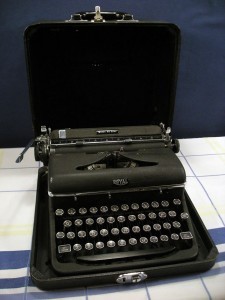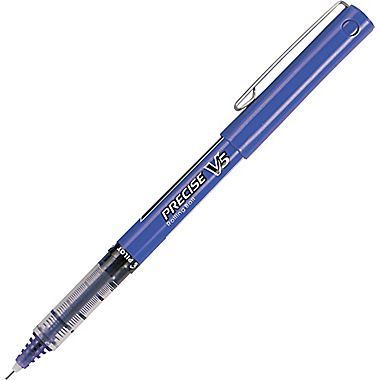This week, in the interest of protecting my own fragile psyche (and fingers) I’m changing tack from Enormous Essays and Deep Thoughts to talk about tools. I spend a lot of time thinking about the writing process, and a lot of time writing, and it seems to me that the internet does as well, especially if the occasional explosion of interest around products like the Hemingwrite is any indication. I’ve tried a lot of input methods in my time, and I’ve never summed up my feelings about them in one place. So let this be that place!
Typewriters

I wrote my first stories on a typewriter a lot like this, back in the kindergarten days—I seriously doubt it was a vintage Royal, but so much about the machine pictured above sings in my memory that the model I used can’t have been much different. (The Royal turns out to have been Hemingway’s typewriter!) It was a manual, black with glass keys, that came in a fat black suitcase with latch and handle, much like this one. Manual typewriters have a powerful tactility I’ve never found with any other writing method. You write slow this way, because each key press is the swing of a hammer. Of course, once you have written, you then reread and scream when you notice a typo or misspelling that will force you to redo everything. I miss the typewriter, but I love on-screen editing. Then again, I’ve retyped each sentence you just read at least three times in the course of finishing this paragraph. Maybe there’s something to be said for hammering your words into the world.
Of course, if I used a manual typewriter I’d just have to retype everything digitally. (Unless I got one of these beauties, or scanned the typescript with OCR software.) And there’s no way to take a typewriter to a coffee shop without being That Guy. Let’s face it, I already wear flannel, own a Chemex, and write novels in coffee shops. I don’t need any more help to be That Guy. Though maybe I should just embrace That Guyness and the suitcase typewriter at once? I’m sure lugging one of these fine pieces of engineering around would do wonders for my shoulder.
Pencil

When I was a kid in school I had to write everything out longhand in #2 pencil, with spaces between the lines. That’s how I learned penmanship, or something like it. I almost never write with pencils any more, but damn if I don’t love the idea. Especially the idea for these pencils, which my friend Scott gave me as a present. Any Woody Guthrie reference is the right Woody Guthrie reference, but his Woody Guthrie reference is more right than most.
Honestly I can’t say much for or against pencil that I won’t cover later talking about longhand work. John Steinbeck wrote East of Eden in pencil, and if it worked for him it might work for you. Of course, Steinbeck also had someone else to type up his manuscripts.
The Pilot v5
I don’t use these guys much any more, but they were my drug back in high school. The miracle of the v5, and of the Gel-Ink G2s which came along later, is that the ink stays wet for a second or two after it’s laid down. It lies on the page thick and opaque, and it sparkles like a star in that second before it dries. I wrote hundreds of pages chasing those stars, barely thinking about the words I produced, trapped in a sort of autohypnotic state. Send help!
Except don’t.
Snooty Pens

These aren’t actually all that snooty: the Lamy Safari and the Yingxiong are both relatively cheap converter-fill fountain pens that last forever, and I love them the way I love swordfighting or any other impractical problem solving method. There’s a ritual to filling the pen, covering myself with ink, cleaning up, apologizing profusely to my wife, discovering that the ink bleeds straight through half my notebooks, finding new notebooks, etc. that recaptures some of the fun of being an old-days being of letters, minus the likelihood of imprisonment and execution as a reward for my work . Joking aside, there’s a great smooth feeling to writing with a fountain pen, and, as with handwriting more broadly construed, I find it works more at the speed of my brain. I can type very quickly. I can reach the end of a sentence before I know what the end of that sentence should be. Even at my most chicken-scratch, when I write by hand I have plenty of time to consider ten or so different approaches to the remainder of the sentence—sometimes I’ll even frame the next one in mind before I start writing!
The Alphasmart Neo

Pictured here with three books I’ve written using the device, which tells you something. The Alphasmart is basically a graphing calculator brain with a QWERTY keyboard attached. It weighs a couple pounds, is sturdy enough that you could beat a man to death with the thin bit, and gets 800 hours of use on a single charge, and by a single charge I mean “three AA batteries.” No networking capabilities, no fancy froofarah, just a keyboard (a solid one, too, recalling the old and I mean old Dell laptop keyboards), and a screen that holds six to eight lines of text at once. Back when laptops were serious spine-distortion engines, I’d chuck this guy in my shoulder bag without a case and just go for a weekend. I’ve written with him everywhere. The Alphasmart company went out of business for a number of reasons, among them, as I understand it, that their machines never break. They’re perfect at their assigned task, and no one who bought one ever needed a replacement.
This is the writing method I’ve used closest to the Hemingwrite, minus the Dropbox sync and e-ink screen of the modern device. The Hemingwrite’s very interesting to me, though it preserves two parts of the Alphasmart experience I did not love, for all the wonder and liberation my Alphasmart supplied. First, the Alphasmart is not that ergonomical. I ended up curled over that little LCD screen like a brine shrimp. Looks like that’s a serious risk with the Hemingwrite too, though perhaps the e-ink screen reduces that likelihood. Second, the screen was so small that I’d end up writing in circles. This may be a me thing, but—editing work I wrote on the Alphasmart involved a lot of repetition removal. I’d write a chapter and move it to the computer to edit, only to discover I’d described the same landscape feature three times, or I’d looped through all the core points of a conversation twice. (Or more, if I was unlucky!) Since moving primary composition to the laptop, where I can see almost an entire page at once, I’ve never had this problem.
Though I’ve had different problems! Like Twitter. So, your milage may vary.
My Laptop

At this point the laptop is my default writing tool. I’ve gone through a few, with an average refresh rate of four years each, and my 2013 Air still takes the prize. It’s light, its battery life might as well be infinite for my purposes (though it’s still two orders of magnitude lower than the Alphasmart’s), and it has all the processing power I need for what I want to do most of the time, which is write while listening to music. I’ve gone through many laptops over the years; the only respect in which the Air lags at all for my purposes is in keyboard—and even there it’s fine, so long as you understand that the keys lack travel and resistance because of physics. What else could you expect from a tool you could throw out with the morning newspaper?
Keyboards

This was my big “you’re being paid to write!!!1one” present: a Leopold Tenkeyless with Cherry MX Blue switches. Mechanical keyboard switches feel cleaner and more precise than dome switches to me, though some of that’s no doubt my imagination. At the very least I find myself bottoming out with full force less often than I do on the laptop keyboard—my usual typing strength is a bit, let’s say, insistent, which came, I’m sure, from learning to type on a manual typewriter, followed by an Apple II+.
A Special Note on Tablets
In theory the tablet is the perfect device for someone like me: it’s light, it works in portrait mode, it has good battery life, and it will Receive my Words. However! For me, typing on screen feels like death. I touch type. I touch type fast. Absent a good keyboard, and none of the keyboards I’ve tried so far have been good enough (requirements: full-sized or close to it, and portable enough to keep the keyboard/tablet combo preferable to the laptop), the tablet enforces a furious concision that has more to do with my wrists and patience than it does with depth of thought. Maybe the Textblade will resolve this issue; I’ll report back when and if mine ever arrives.
Takeaways
What, we need takeaways now? Well, here are a few: write with what you have to hand. If that doesn’t work, ask someone else if you can borrow what they have to hand. The tool doesn’t matter, but tools are fun; romanticizing the writing process can be a trap, but then, writing is hard, and if something fills it with romance to you—if that’s what you need to write, to work—embrace it. Then, at some point, try writing without it, and see if what you write, or how, changes.
Or don’t. I mean, honestly, this isn’t so much advice as “here are some things I’ve tried.” The way the words get down doesn’t matter so much, but it’s a lot easier to discuss than why the words get down, and sometimes it’s fun to talk shop.
 newest »
newest »
 newest »
newest »
 I've used Scrivener for the last five years, though Word worked just fine before that, and Word's new full screen "focus" mode gives Word users access to what used to be Scrivener's killer app. I edit in the height of luxury—I sync my Scrivener project to a Dropbox text directory, then edit on a tablet, which changes the form of the text enough that I can catch errors I wouldn't have on the laptop screen.
I've used Scrivener for the last five years, though Word worked just fine before that, and Word's new full screen "focus" mode gives Word users access to what used to be Scrivener's killer app. I edit in the height of luxury—I sync my Scrivener project to a Dropbox text directory, then edit on a tablet, which changes the form of the text enough that I can catch errors I wouldn't have on the laptop screen.
 Hmm... That is an interesting idea... I never thought about changing the perspective of reading, by just changing the device before. I can see how that would change the focus and how you see the words and story differently.
Hmm... That is an interesting idea... I never thought about changing the perspective of reading, by just changing the device before. I can see how that would change the focus and how you see the words and story differently.










With your laptop which writing software do you use, or use most often?
Do you have a preference for the straight laced word processor like Word, or Wordpad? Or do you use a more specific software like Scrivener or a combo thereof?
Curious what works best for your writing.
-Raavyn